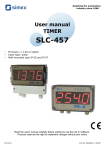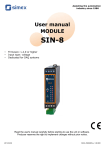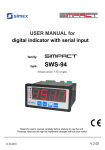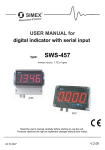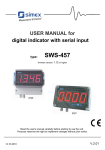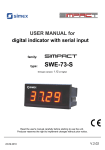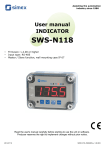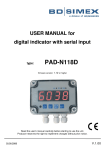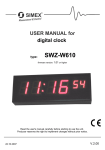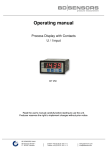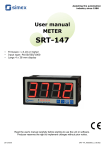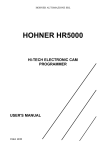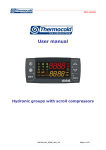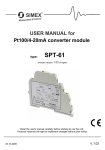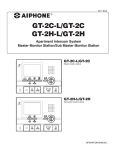Download SW-BCD-94 - Sincro Systems
Transcript
SIMEX ® USER MANUAL for universal indicator family: type: SW-BCD-94 firmware version: 3.4 or higher Read the user's manual carefully before starting to use the unit. Producer reserves the right to implement changes without prior notice. 22.10.2007 V.2.00 User manual for universal indicator SW-BCD-94 CONTENTS 1. BASIC REQUIREMENTS AND USER SAFETY........................................................................................3 2. GENERAL CHARACTERISTICS................................................................................................................4 3. TECHNICAL DATA......................................................................................................................................4 4. DEVICE INSTALLATION............................................................................................................................6 4.1. UNPACKING.......................................................................................................................................6 4.2. ASSEMBLY........................................................................................................................................6 4.3. CONNECTION METHOD...................................................................................................................8 4.4. MAINTENANCE................................................................................................................................13 5. FRONT PANEL DESCRIPTION................................................................................................................13 6. PRINCIPLE OF OPERATION...................................................................................................................14 6.1. DISPLAYING MODE........................................................................................................................14 7. DEVICE PROGRAMMING.........................................................................................................................15 7.1. PROGRAMMING MENU..................................................................................................................15 7.2. PARAMETERS EDITION.................................................................................................................16 7.2.1. Numeric parameters (digit change mode)...............................................................................16 7.2.2. Numeric parameters (slide change mode)..............................................................................16 7.2.3. Switch parameters (“LIST” type).............................................................................................17 7.3. MENU DESCRIPTION.....................................................................................................................17 7.3.1. ”bri” parameter.........................................................................................................................18 7.3.2. ”dAtA” menu...........................................................................................................................18 7.3.3. ”PAr” menu..............................................................................................................................21 7.3.4. ”rS” menu.................................................................................................................................23 7.3.5. ”Scod” parameter....................................................................................................................24 7.3.6. ”Edit” parameter......................................................................................................................24 7.3.7. ”dEFS” parameter....................................................................................................................24 7.4. MENU STRUCTURE........................................................................................................................25 8. THE MODBUS PROTOCOL HANDLING.................................................................................................26 8.1. LIST OF REGISTERS......................................................................................................................26 8.2. TRANSMISSION ERRORS DESCRIPTION....................................................................................28 8.3. EXAMPLES OF QUERY/ANSWER FRAMES.................................................................................29 9. DEFAULT AND USER'S SETTINGS LIST...............................................................................................31 2 User manual for universal indicator SW-BCD-94 Explanation of symbols used in the manual: ! - This symbol denotes especially important guidelines concerning the installation and operation of the device. Not complying with the guidelines denoted by this symbol may cause an accident, damage or equipment destruction. IF THE DEVICE IS NOT USED ACCORDING TO THE MANUAL THE USER IS RESPONSIBLE FOR POSSIBLE DAMAGES. i - This symbol denotes especially important characteristics of the unit. Read any information regarding this symbol carefully 1. BASIC REQUIREMENTS AND USER SAFETY ! - The manufacturer is not responsible for any damages caused by inappropriate installation, not maintaining the proper technical condition and using the unit against its destination. - Installation should be conducted by qualified personnel . During installation all available safety requirements should be considered. The fitter is responsible for executing the installation according to this manual, local safety and EMC regulations. - The unit must be properly set-up, according to the application. Incorrect configuration can cause defective operation, which can lead to unit damage or an accident. - If in the case of a defect of unit operation there is a risk of a serious threat to the safety of people or property additional, independent systems and solutions to prevent such a threat must be used. - The unit uses dangerous voltage that can cause a lethal accident. The unit must be switched off and disconnected from the power supply prior to starting installation of troubleshooting (in the case of malfunction). - Neighbouring and mating equipment must meet the requirements of appropriate standards and regulations concerning safety and be equipped with adequate anti-overvoltage and anti-interference filters. - Do not attempt to disassemble, repair or modify the unit yourself. The unit has no user serviceable parts. Units, in which a defect was stated must be disconnected and submitted for repairs at an authorized service centre. ! - In order to minimize fire or electric shock hazard, the unit must be protected against atmospheric precipitation and excessive humidity. - Do not use the unit in areas threatened with excessive shocks, vibrations, dust, humidity, corrosive gasses and oils. - Do not use the unit in explosion hazard areas. 3 User manual for universal indicator SW-BCD-94 ! - Do not use the unit in areas with significant temperature variations, exposed to condensation or icing. - Do not use the unit in areas exposed to direct sunlight. - Make sure that the ambient temperature (e.g. inside the control box) does not exceed the recommended values. In such cases forced cooling of the unit must be considered (e.g. by using a ventilator). ! The unit is designed for operation in an industrial environment and must not be used in a household environment or similar. 2. GENERAL CHARACTERISTICS The SW-BCD-94 is designed for displaying numerical values, some letters and user defined alphanumerical signs. Additionally user allows to set the bright of the display in eight steps. The data can be delivered to the device via parallel (8/4 bits data plus 4/1 bits of strobe/address/enable) or RS-485 serial interface. Display type SW-BCD-94 can be used as indication output of PLC controllers, for data displaying in BCD, binary, ASCII, or byte formats. Depending on settings the device can display data as: • numerical data (mode „bcd”: numbers 0 ÷ 9 and sign „-”), with settable decimal point position, and blanking of non significant zeros. A lot of displays can be controlled by one PLC, displaying process data on synoptic boards. e.g. „ 0.12”, „1.234”, „- 50” • Binary data (mode „bin”, numbers: 0 ÷ 9, and letters A ÷ F), in example displaying state of address lines - „AbF3” • messages (including mixed numbers and letters) possible to show on 7-segment displays. (modes „ASCI” and „bytE”), e.g.: “Err”, “oFF”, “on”, “StoP”, „23 L”, „P -7” and any other messages. The communication via RS-485 uses MODBUS RTU protocol, and baud rate can be selected by user from: 1200 ÷ 115200 baud. 3. TECHNICAL DATA Power supply voltage (depending on version) External fuse (required) Power consumption 85...230...260V AC/DC; 50 ÷ 60 Hz or 19...24...50V DC; 16...24...35V AC T - type, max. 2 A max. 4.5 VA @ 85 ÷ 260V AC/DC max. 4.5 VA @ 16V ÷ 35V AC max. 4.5 W @ 19V ÷ 50V DC Parallel inputs 4 inputs of strobe / address / enable 16 data inputs (4 decades of 4 bits, or two bytes ) Strobe pulse width min. 1 ms 4 User manual for universal indicator SW-BCD-94 Input levels low level: high level: 0V ÷ 2V 4V ÷ 24V Power supply output 24V +5%, -10% / max. 100 mA, stabilized Display range Digits, letters and signs possible to show on 7-segment displays. Communication interface RS 485, 8N1 and 8N2, Modbus RTU, not separated Baud rate 1200 bit/s ÷ 115200 bit/s Display (depending on version) LED, 4 digit, 20mm height, red or LED, 4 digit, 20mm height, green Data memory non-volatile memory, EEPROM type Protection level IP 65 (from front, after using waterproof cover) IP 40 (from front) IP 20 (housing and connection clips) Housing type Housing material Housing dimensions Mounting hole Assembly depth Panel thickness panel NORYL - GFN2S E1 96 x 48 x 100 mm 90.5 x 43 mm 102 mm max. 5 mm Operating temperature Storage temperature Humidity Altitude 0°C to +50°C -10°C to +70°C 5 to 90% no condensation up to 2000 meters above sea level Screws tightening max. torque Max. connection leads diameter Safety requirements 0,5 Nm 2,5 mm2 according to: PN-EN 61010-1 installation category: II pollution degree: 2 voltage in relation to ground: 300V AC EMC ! insulation resistance: >20MΩ insulation strength between power supply and input/output terminal: 1min. @ 2300V according to: PN-EN 61326 This is a class A unit. In housing or a similar area it can cause radio frequency interference. In such cases the user can be requested to use appropriate preventive measures. 5 User manual for universal indicator SW-BCD-94 4. DEVICE INSTALLATION The unit has been designed and manufactured in a way assuring a high level of user safety and resistance to interference occurring in a typical industrial environment. In order to take full advantage of these characteristics installation of the unit must be conducted correctly and according to the local regulations. ! - Read the basic safety requirements on page 3 prior to starting the installation. - Ensure that the power supply network voltage corresponds to the nominal voltage stated on the unit’s identification label. - The load must correspond to the requirements listed in the technical data. - All installation works must be conducted with a disconnected power supply. - Protecting the power supply clamps against unauthorized persons must be taken into consideration. 4.1. UNPACKING After removing the unit from the protective packaging, check for transportation damage. Any transportation damage must be immediately reported to the carrier. Also, write down the unit serial number on the housing and report the damage to the manufacturer. Attached with the unit please find: - user’s manual, - warranty, - assembly brackets - 2 pieces. 4.2. ASSEMBLY ! - The unit is designed for mounting indoor inside housings (control panel, switchboard) assuring appropriate protection against electric impulse waves. Metal housing must be connected to the grounding in a way complying with the governing regulations. - Disconnect the power supply prior to starting assembly. - Check the correctness of the performed connections prior to switching the unit on. ! 6 In order to assembly the unit, a 90,5 x 43 mm mounting hole (Figure 4.1) must be prepared. The thickness of the material of which the panel is made must not exceed 5mm. When preparing the mounting hole take the grooves for catches located on both sides of the housing into consideration (Figure 4.1). Place the unit in the mounting hole inserting it from the front side of the panel, and then fix it using the brackets (Figure 4.2). The minimum distances between assembly holes’ axes - due to the thermal and mechanical conditions of operation - are 115 mm x 67mm (Figure 4.3). User manual for universal indicator SW-BCD-94 90,5 mm 13 mm 43 mm 8 mm 8 mm 13 mm max. 5 mm 1 mm 1 mm Figure 4.1. Mounting hole dimensions 8,5 mm 16 mm 92 mm 8 mm 12 mm 10 mm Figure 4.2. Installing of brackets, and dimensions of connectors. 67 mm 115 mm Figure 4.3. Minimum distances when assembly of a number of units 7 User manual for universal indicator SW-BCD-94 4.3. CONNECTION METHOD Caution ! - Installation should be conducted by qualified personnel . During installation all available safety requirements should be considered. The fitter is responsible for executing the installation according to this manual, local safety and EMC regulations. - The unit is not equipped with an internal fuse or power supply circuit breaker. Because of this an external time-delay cut-out fuse with minimal possible nominal current value must be used (recommended bipolar, max. 2A) and a power supply circuit-breaker located near the unit. In the case of using a monopolar fuse it must be mounted on the phase cable (L). - The power supply network cable diameter must be selected in such a way that in the case of a short circuit of the cable from the side of the unit the cable shall be protected against destruction with an electrical installation fuse. - Wiring must meet appropriate standards and local regulations and laws. - In order to secure against accidental short circuit the connection cables must be terminated with appropriate insulated cable tips. - Tighten the clamping screws. The recommended tightening torque is 0.5 Nm. Loose screws can cause fire or defective operation. Over tightening can lead to damaging the connections inside the units and breaking the thread. - In the case of the unit being fitted with separable clamps they should be inserted into appropriate connectors in the unit, even if they are not used for any connections. - Unused clamps (marked as n.c.) must not be used for connecting any connecting cables (e.g. as bridges), because this can cause damage to the equipment or electric shock. - If the unit is equipped with housing, covers and sealing packing, protecting against water intrusion, pay special attention to their correct tightening or clamping. In the case of any doubt consider using additional preventive measures (covers, roofing, seals, etc.). Carelessly executed assembly can increase the risk of electric shock. - After the installation is completed do not touch the unit’s connections when it is switched on, because it carries the risk of electrical shock. 8 User manual for universal indicator SW-BCD-94 Due to possible significant interference in industrial installations appropriate measures assuring correct operation of the unit must be applied. To avoid the unit of improper indications keep recommendations listed below. – Avoid common (parallel) leading of signal cables and transmission cables together with power supply cables and cables controlling induction loads (e.g. contactors). Such cables should cross at a right angle. – Contactor coils and induction loads should be equipped with anti-interference protection systems, e.g. RC-type. – Use of screened signal cables is recommended. Signal cable screens should be connected to the earthing only at one of the ends of the screened cable. – In the case of magnetically induced interference the use of twisted couples of signal cables (so-called “spirals”) is recommended. The spiral (best if shielded) must be used with RS-485 serial transmission connections. – In the case of interference from the power supply side the use of appropriate antiinterference filters is recommended. Bear in mind that the connection between the filter and the unit should be as short as possible and the metal housing of the filter must be connected to the earthing with largest possible surface. The cables connected to the filter output must not run in parallel with cables with interference (e.g. circuits controlling relays or contactors). max. 2 mm Connections of power supply voltage and measurement signals are executed using the screw connections on the back of the unit’s housing. 6-7 mm Figure 4.4. Method of cable insulation replacing and cable terminals ! All connections must be made while power supply is disconnected ! 9 User manual for universal indicator SW-BCD-94 +24V +5%, -10% Imax = 100mA Strobe/Address + Uo - 1 2 3 4 Decade 4 Decade 3 1 2 3 4 1 2 3 4 20 21 22 23 24 25 26 27 28 29 30 31 32 33 1 2 Power supply 3 4 5 DATAGND DATA+ (depending on version) RS - 485 6 7 8 9 10 11 12 13 1 2 3 4 1 Decade 1 2 Decade 2 Figure 4.5. Terminals description L N 1 2 N FUSE L Depending on version: 85...230...260V AC/DC or 19...24...50V DC; 16...24...35V AC Figure 4.6. Connection of power supply 10 3 4 User manual for universal indicator SW-BCD-94 1 2 3 Decade 4 Decade 3 Strobe 4 1 2 3 4 1 2 3 4 20 21 22 23 24 25 26 27 28 29 30 31 32 33 +24V 6 7 8 9 10 11 12 13 1 2 3 4 1 2 3 4 Decade 2 Decade 1 Figure 4.7. All decades latched by one strobe signal: „Strb”=”Str1” (available only while „modE”=”bin” or ”bcd”) Strobe 1 2 3 4 20 21 22 23 24 25 +24V 6 7 8 9 1 2 3 4 Decade 1 ÷ 4 (depending on strobe) Figure 4.8. Individual strobe signals for every decade: „Strb”=”Str4”, parameter „modE”=”bin” or ”bcd” 11 User manual for universal indicator SW-BCD-94 Strobe 1 2 3 4 20 21 22 23 24 25 +24V 6 7 8 9 10 11 12 13 A 0 B 1 C 2 D 3 E 4 F 5 G 6 DP (while „bytE” mode) 7 (while „ASCI” mode) Figure 4.9. Individual strobe signals for every decade: „Strb”=”Str4”, parameter „modE”=”bytE” or ”ASCI” Strobe Enable A0 A1 i To allow storing of data, Enable input should be driven low or not connected 20 21 22 23 24 25 +24V 6 7 8 9 1 2 3 4 Decade 1 ÷ 4 (depending on Address) Figure 4.10. Individual addressing of the decades: „Strb”=”StrA”, parameter „modE”=”bin” or ”bcd” 12 User manual for universal indicator SW-BCD-94 Strobe Enable A0 A1 i 20 21 22 23 24 25 To allow storing of data, Enable input should be driven low or not connected +24V 6 7 8 9 10 11 12 13 A 0 B 1 C 2 D 3 E 4 F 5 G 6 DP (while „bytE” mode) 7 (while „ASCI” mode) Figure 4.11. Individual addressing of the decades: „Strb”=”StrA”, parameter „modE”=”bytE” or ”ASCI” 4.4. MAINTENANCE The unit does not have any internal replaceable or adjustable components available to the user. Pay attention to the ambient temperature in the room where the unit is operating. Excessively high temperatures cause faster ageing of the internal components and shorten the fault-free time of unit operation. In cases where the unit gets dirty do not clean with solvents. For cleaning use warm water with small amount of detergent or in the case of more significant contamination ethyl or isopropyl alcohol. ! Using any other agents can cause permanent damage to the housing. Product marked with this symbol should not be placed in municipal waste. Please check local regulations for disposal and electronic products. 5. FRONT PANEL DESCRIPTION display LEDs AL R1 R2 R3 R4 ESC MENU ENTER programming pushbuttons 13 User manual for universal indicator SW-BCD-94 Symbols and functions of push-buttons: Symbol used in the manual: [ESC/MENU] ESC MENU Functions: • Enter to main menu ( press and hold by at least 2 sec.) • Exit the current level and Enter to previous menu (or measure mode) • Cancel the changes made in parameter being edited ENTER Symbol used in the manual: [ENTER] Functions: • Start to edit the parameter • Enter to the sub-menu, • Confirmation of changes made in parameter being edited Symbol used in the manual: [^] [v] Functions: • Change of the present menu, • Modification of the parameter value, • Change of the display mode. 6. PRINCIPLE OF OPERATION After turning the power supply on, device ID and software version are showed on the display, next the digital indicator goes to the display mode. 6.1. DISPLAYING MODE Directly after enter displaying mode, device displays “- - - -” info as long as first actualization of displayed value (by strobe signal) comes. Delivering of active strobe signal to suitable lines of parallel input causes in displaying of stored data accordingly to configuration (see Menu ”PAr” and Menu ”dAtA”). Four modes are available: • „bcd” - numbers „0” ÷ „9” and sign ”-”, • „bin” - numbers „0” ÷ „9”, and letters „A” ÷ „F”, • „bytE” - individual driving of segments in every decade • „ASCI” - ASCII coded numbers and letters (possible to show on 7-segment display). 14 User manual for universal indicator SW-BCD-94 decade no 4 decade no 3 decade no 2 decade no 1 Figure 6.1. The numbering of display decades The serial input (RS-485 with MODBUS RTU) can be selected as alternative source of display data. While displaying, time periods between successive writings to display data registers are controlled for parallel input as well serial input. When defined time period elapsed (and data is not refreshed) the device starts to signal this situation, flashing last stored data with symbols “- - - -” in alternative mode. All accessible parameters can be changed by entering the menu (see: DEVICE PROGRAMMING). Use the local keyboard or the remote controller to do it. (Note: all parameters can be remote changed via RS-485 interface). i Configuration of the device (via menu or RS 485 interface) do not stops device. 7. DEVICE PROGRAMMING The device menu allow user to set all parameters connected to operation of measurement input, control modes, critical situations behaviour, communication via RS-485 and access settings. The meaning of the particular parameters is described in paragraph MENU DESCRIPTION. 7.1. PROGRAMMING MENU To enter main menu (being in the measurement mode) operator must to press and hold at least 2 sec. [ESC/MENU] button. If the user password is defined (see parameter “Scod“), operator have to enter correct one before proceeding to menu options . Entering of the passwords is similar to the edition of numeric parameters (see: PARAMETERS EDITION ), however presently editing digit is showed only on the display, other digits are replaced by “-” sign. After entering of last digit of the password first menu position will be displayed (if the password is correct) or warning ”Err” in other case. 15 User manual for universal indicator SW-BCD-94 Functions of the buttons while sub-menu and parameters choice: Selection of sub-menu or parameter for editing. Name of selected item (submenu or parameter) is displayed. ENTER ESC MENU i Operation of [ENTER] button depend on present menu position: • if the name of some sub-menu is displayed - enter this sub-menu; name of the first parameter (or next level sub-menu) is displayed, • if the name of some parameter is displayed - enter the edition of this parameter; present value of the parameter is displayed, [ESC/MENU] button allow user to exit present menu level and goes to upper level menu (or measurement mode). After about 1 min. since last use of the buttons, device exits the menu mode and returns to the measurement mode (only if no parameters are in editing mode). 7.2. PARAMETERS EDITION To start edition of any parameter user should select name of desired one using [^] [v] buttons and then press [ENTER]. 7.2.1. Numeric parameters (digit change mode) Numerical parameters are displayed as decimal numbers. The mode of its new value entering depends on chosen edit method ( see parameter „Edit”). In mode “by digit” („Edit”=”dig”) pressing one of the keys [^] or [v] causes change of current position (flashing digit) or the sign (+/-). Short pressing of the [ENTER] button causes change of the position (digit). Press [ENTER] at least 2 seconds to accept the changes, after that question ”SEt?” is displayed, and user must to confirm (or cancel) the changes. To conform changes (and story it in EEPROM) press [ENTER] button shortly after ”SEt?” is displayed. To cancel the changes press [ESC] button shortly after ”SEt?” is displayed. After that device returns to the menu. 7.2.2. Numeric parameters (slide change mode) In “slide change” mode („Edit”=”Slid”), buttons [^] and [v] has different functions. To increase edited value press (or press and hold) [^] button only, the increasing became quickest as long as button [^] is pressed. To slow down the increasing, button [v] can be used. If [v] is pressed shortly (and button [^] is still pressed), increasing slow down for a moment only, if [v] is pressed and held while button [^] is still pressed the increasing slow down and will be kept on lower speed. To decrease edited value press (or press and hold ) [v] button only. The decreasing became quickest as long as button [v] is pressed. To slow down the decreasing, button [^] can be used. If [^] is pressed shortly (and button [v] is still pressed), decreasing slow down for a moment only, if [^] is pressed and held while button [v] is still pressed the decreasing slow down and will be kept on lower speed. 16 User manual for universal indicator SW-BCD-94 Press [ENTER] at least 2 seconds to accept the changes, after that question ”Set?” is displayed, and user must to confirm (or cancel) the changes. To conform changes (and story it in EEPROM) press [ENTER] button shortly after ”SEt?” is displayed. To cancel the changes press [ESC] button shortly after ”SEt?” is displayed. After that device returns to the menu. 7.2.3. Switch parameters (“LIST” type) Switch parameters can be described as a sets of values (a lists) out of which only one of the options available on the list can be selected for the given parameter. Options of switching parameter are selected using [^], [v] keys. Short pressing of [ENTER] causes in displaying of the acknowledge question (”SEt?”). If key [ENTER] is pressed again, the changes are accepted, stored in EEPROM end the edition process finished. Pressing the key [ESC] after ”SEt?” causes in cancelling of made changes and returning to menu. Functions of buttons when editing numeric and switching parameters: While editing numeric parameter: • change of current (flashing) digit • slide change of value (acceleration, deceleration, direction change) While editing switch parameter - selection of switch parameter. ENTER ESC MENU If numerical parameter is being edited, a short press of [ENTER] button change edited position. A long press of [ENTER] button (at lest 2 sec.) causes of display a ”SEt?” ask, which allow user to make sure if change of the parameter value is correct. If switch parameter is being edited, a short press of [ENTER] button causes of display a ”SEt?” ask. When [ENTER] button is pressed again (while ”SEt?” is displayed) the new value of the parameter is stored in EEPROM memory. Pressing this button operator can cancel the changes done up to now (if they were not approved by [ENTER] button after the ”SEt?” ask) and come back to menu 7.3. MENU DESCRIPTION “- - - -” i - password checking. If some password different from „0000” is set, then every enter to main menu follows the entering of password. If entered password is correct then first menu position will be displayed else warning ”Err”, and unit returns to measurement mode. Due to problem with direct displaying of “m” letter, it is exchanged with special sign “ “. Independently in user manual letter „m” is used to make it more readable (example: “modE”). 17 User manual for universal indicator SW-BCD-94 7.3.1. ”bri” parameter This parameter allows user to set bright of the LED display, conventional values from 1 to 8. bright can be set to 7.3.2. ”dAtA” menu This menu allows to select data source, data coding mode, and decimal point position. ”Src” - data source: ”PAr” - parallel input ”rS” - serial input (RS 485, MODBUS RTU) ”modE” - data coding : ”bcd” - BCD code; digits 0 ÷ 9 and sign ”-” for value 0x0F ”bin” - binary code; alphanumerical signs 0 ÷ F (see Tab.7.1) Input line No. 1 2 3 4 Weight 1 2 4 8 Tab.7.1. The weights of bits in every decade for coding modes ”bcd” and ”bin” i 18 In ”bcd” mode displayed value is available in register 01h as 2-bytes signed value (U2 coded). Spaces and „-” between visible digits are converted as 0. Sign „-” on the highest visible place is converted as sign of digit, and visible digits (right side of „-”) are converted to negative numbers. Examples („_” means space): „0001” = 1; „-001” = -1; „_-_2” = -2; „3-_5” = 3005; „420” = 4020; „--2_” = -20;„----”= 0; „-0_-”= 0. In all other coding modes (”bin”, ”bytE” and ”ASCI”) the value returned by register 01h is 0 independently on displayed value; User manual for universal indicator SW-BCD-94 ”bytE” - direct driven segments of 7-segment display (see Tab.7.2) ”ASCI” - ASCII code; the value delivered to decade 1 and 2 are handled as one ASCII sign (see Tab.7.2). Signs possible to display on 7-segment display related to ASCII codes are presented in Tab.7.3, In this mode bit 7 is ignored. Decade 1 Decade No. Decade 2 Input line No. 1 2 3 4 1 2 3 4 Segment number A B C D E F G DP ASCII code bit No. 0 1 2 3 4 5 6 7 Tab.7.2. The relation between 7-segment display segments and data inputs for coding in ”bytE” and ”ASCI” modes. ”Pnt” - decimal point position (only for ”bcd”,”bin”and ”ASCI” modes). Available settings: ” 0” ” 0.0” ” 0.00” ”0.000” ” 0000” ”000.0” ”00.00” - with blanking of non significant zeros, - with blanking of non significant zeros, - with blanking of non significant zeros, - without blanking of non significant zeros - all positions displayed - without blanking of non significant zeros - all positions displayed - without blanking of non significant zeros - all positions displayed 19 User manual for universal indicator SW-BCD-94 CODES bits 7..3 bits 2..0 000 001 010 011 100 101 110 00000 00001 00010 00011 00100 00101 00110 00111 01000 01001 01010 01011 01100 01101 01110 01111 Tab.7.3. 7-segment signs related to ASCII codes. 20 111 User manual for universal indicator SW-BCD-94 7.3.3. ”PAr” menu Settings of parallel input: ”Strb” - allows to set method of data entering via parallel input. Available settings: ”Str1” - one, common strobe signal for all decades. Every decade has its own (separate) inputs (see Figure 4.7) . This selection is active only for ”bin” and ”bcd” coding; for ”ASCI” and ”bytE” modes is it ignored. ”Str4” - separate strobe for every decade. All decades use the same data inputs (see Figure 4.8 for ”bin” and ”bcd” , and Figure 4.9 for ”ASCI” and”bytE” modes) ”StrA” - one common strobe signal, and two address lines for decade selection, additional enable signal; Every decade has individual address (0-3). The data is being stored while active strobe and Enable low (or not connected) occur (see Figure 4.10 for ”bin” and ”bcd” , and Figure 4.11 for ”ASCI” and ”bytE” modes). Address : A1, A0 00 01 10 11 Selected decade 1 2 3 4 Tab.7.4. The addressing of decade in ”StrA” mode of parallel input i In ”ASCI” and ”bytE” coding, ”Str1” mode is ignored and replaced by ”Str4”. ”CLoc” - allows to select active state of strobe signals; possibilities: ”Hi” - active state - HIGH. Storing of the data from data inputs to data registers is being realised while HIGH state on strobe input occurs. All changes on data lines, while HIGH state on strobe line, are shown immediately on the display. Last state of data lines directly before strobe goes LOW will be stored to data registers. Data store eneble Data hold min. 1 ms Data hold 21 User manual for universal indicator SW-BCD-94 “Lo” - active state - LOW. Storing of the data from data inputs to data registers is being realised while LOW state on on strobe input occurs. All changes on data lines, while LOW state on strobe line, are shown immediately on the display. Last state of data lines directly before strobe goes HIGH will be stored to data registers. Data hold Data hold min. 1 ms Data store enabled “H - L” - HIGH-LOW transient (falling edge). Data are being stored to data registers while falling edge on strobe line occurs. Last state of data lines directly before strobe goes from HIGH to LOW will be stored to data registers. Changes of data lines while strobe signal is stable are ignored DATA Data stored min. 1 ms min. 1 ms ”L - H” - LOW-HIGH transient (rising edge). Data are being stored to data registers while rising edge on strobe line occurs. Last state of data lines directly before strobe goes from LOW to HIGH will be stored to data registers. Changes of data lines while strobe signal is stable are ignored. DATA Data stored min. 1 ms min. 1 ms 22 User manual for universal indicator SW-BCD-94 i ”tout” 1. Sampling of strobe lines is repeated every 0.8 ms, 1. While settings: “CLoc” = “Hi” or ”Lo” pulses shorter than 1ms can be ignored. 2. All changes on data lines occurs shorter than 0.8ms before change of strobe signal can be ignored for all settings of Cloc parameter. 3. A stable states on data and address lines have to last at least 1ms before and after active edges on strobe line, for CLoc = “H - L” and “L - H” . - this parameter defines maximal time period (in seconds) between successive data storing (active strobe signals) on parallel input. If this time is exceeded, currently displayed value starts flash. Parameter “tout” can be set in range 0 to 99 seconds. Value 0 turns off the control of time before successive data storing. 7.3.4. ”rS” menu This menu is connected with RS-485 interface, and sets his properties: ”Addr” - this parameter defines the address of the device, accordingly to Modbus protocol. It can be set in range from 0 to 199. If the value 0 is set then device, responds to frames with address 255 (FFh). ”bAud” - this parameter determines RS-485 interface baud rate. It can be set to one of 8 possible values: ”1.2”, ”2.4”, ”4.8”, ”9.6”, ”19.2”, ”38.4”,”57.6”,”115.2”, which respond to the baud rates of 1200, 2400, 4800, 9600, 19200, 38400, 57600 and 115200 bit/s respectively. ”mbAc” - this parameter sets the access to the configuration registers of the device. Possible values: ”on” - configuration registers can be set via RS-485 interface, ”oFF” - configuration registers can not be set via RS-485 interface. ”mbtO” - this parameter defines maximal time (sec) between following frames received by the device. If the delay will be greater than the value of ”mbtO” parameter, displayed value starts blinking. Parameter “mbtO” can be set to values from 0 to 99 seconds. The value 0 means that the time will be not controlled. “rESd” - this parameter defines minimal (additional) delay between the Modbus message and the answer of the device (received and sent via RS-485 interface). This additional delay allows the device to work with poor RS-converters which do not works properly on baud rates higher than 19200. This parameter can be set to one of values: ”Std” ” 10c” ” 20c” ” 50c” ”100c” ”200c” - answer as quick as possible, no additional delay - answer delayed of 10, 20, 50, 100 of 200 chars respectively, where one character time depends on selected baud rate 23 User manual for universal indicator SW-BCD-94 i In the most cases parameter ”rESd” should be set to ”Std” (no additional delay). Unfortunately for some third party RS-converters ”rESd” should be adjusted experimentally. Table 7.5 contains most frequently used values. ”bAud” parameter “38.4” “57.6” “115.2” ”rESd” parameter “ 10c” “ 20c” “ 50c” Tab.7.5. Settings of ”rESd” parameter 7.3.5. ”Scod” parameter This parameter defines user password (4-digits number). If this parameter is set at value “0000”, user password is turned off. If the user do not remember his password, the access to the menu is possible by the “one-use password”. To get this password please contact with Marketing Division. “Single use password” can be used only one time, after that it is destroyed. Entering this password causes in clearing of user password, it means sets the user password to „0000”. i The “one-use password” can be used ONE TIME ONLY, it is impossible to use it again! The “one-use password” can be restored by Service Division only. 7.3.6. ”Edit” parameter This parameter allows to change the edition mode of numerical parameters: ”dig” - the change to “by digit” mode, ”Slid” - slide change mode. 7.3.7. ”dEFS” parameter This setting allows to restore the factory settings of the device. To get the access to this option special password is required: „5465”, next the device displays acknowledge question „SEt?”. Press [ENTER] to acknowledge the restoring of factory settings or [ESC] to cancel. 24 User manual for universal indicator SW-BCD-94 7.4. MENU STRUCTURE Displaying mode ESC ESC MENU MENU Press and hold at least 2 seconds 0___ 4-digit user password entering (if it is different from „0000”) ENTER ENTER ESC MENU bri ENTER ESC Parameter edition MENU ESC MENU ENTER dAtA ENTER Src ENTER ESC MENU ENTER ESC MENU ENTER ESC MENU Parameter edition modE ENTER Strb PAr ESC MENU ESC Parameter edition Pnt MENU CLoc tout ESC MENU ENTER rS ENTER Addr ENTER ESC Parameter edition MENU bAud ENTER ESC MENU Scod ESC Parameter edition ESC MENU mbAc MENU mbtO ENTER ESC MENU Edit ESC Parameter edition rESd MENU 4-digit special password entering ENTER ESC MENU ENTER 0___ dEFS MENU ENTER SEt? ESC Default settings restoring ESC MENU 25 User manual for universal indicator SW-BCD-94 8. THE MODBUS PROTOCOL HANDLING Transmission parameters: 1 start bit, 8 data bits, 1 or 2 stop bit (2 bits are send, 1 and 2 bits are accepted when receive), no parity control Baud rate: selectable from: 1200 to 115200 bits/second Transmission protocol: MODBUS RTU compatible The device parameters and display value are available via RS-485 interface, as HOLDINGtype registers (numeric values are given in U2 code) of Modbus RTU protocol. The registers (or groups of the registers) can be read by 03h function, and wrote by 06h (single registers) or 10h (group of the registers) accordingly to Modbus RTU specification. Maximum group size for 03h and 10h functions can not exceeds 16 registers (for single frame). i The device interprets the broadcast messages, but then do not sends the answers. 8.1. LIST OF REGISTERS Register Write 01h No The value currently showed on the display for „bcd” coding mode. In all 0÷FFFFh other modes this register returns always 0. See parameter “modE” of “dAtA” submenu for details. 08h Yes 0÷6 Parameter “Pnt” of “dAtA” submenu (decimal point position): 0-” 0”,with blanking of non significant zeros, 1 - “ 0.0”,with blanking of non significant zeros, 2 - “ 0.00”, with blanking of non significant zeros, 3 - “0.000” 4 - “ 0000”, without blanking of non significant zeros, 5 - “000.0”, without blanking of non significant zeros, 6 - “00.00”, without blanking of non significant zeros, 09h Yes 0÷1 “Src” parameter in “dAtA” menu (the source of data to displaying); 0 - parallel input; 1 - serial input - RS 485, MODBUS RTU 0Ah Yes 0÷3 “modE” parameter in“dAtA” menu (coding mode); 0 - „bcd”; 1 - „bin”; 2 - „bytE”; 3 - „ASCI”; 0Bh Yes 0÷1 “Strb” parameter in “PAr” menu (data entering mode); 0 - „Str1”; 1 - „Str4”; 2 - „StrA” 0Ch Yes 0÷3 “CLoc” parameter in “PAr” menu (active state/ edge of strobe); 0 - „Hi”; 1 - „Lo”; 2 - „H-L”; 3 - „L-H”; “tout” parameter in “PAr” menu (maximum time period between successive data storing); 0 - not controlled; 1 ÷ 99 - permissible time period expressed in seconds 26 Range 0Dh Yes 0÷99 0Eh Yes 0÷0Fh 0Fh Yes 0÷FFFFh 10h Yes 0÷FFh Register description Current strobe lines state Current data lines state: decade 4 - bits 15÷12, decade 3 - bits 11÷8, decade 2 - bits 7÷4, decade 1 - bits 3÷0, Sign defined for decade no. 1 (most right, see page 18); User manual for universal indicator SW-BCD-94 Register Write Range 11h Yes 0÷FFh Like above, but refers to decade 2 12h Yes 0÷FFh Like above, but refers to decade 3 13h Yes 0÷FFh Sign defined for decade no. 4 (most right, see page 18); 20h Yes 21h No 206Fh 22h2 Yes 0÷7 “bAud” parameter in “rS” menu (baud rate); 0 - 1200 baud; 1 - 2400 baud; 2 - 4800 baud; 3 - 9600 baud; 4 - 19200 baud; 5 - 38400 baud; 6 - 57600 baud; 7 - 115200 baud 23h Yes 0÷1 “mbAc” parameter in “rS” menu (permission to write registers via RS485 interface); 0 - write denied ; 1 - write allowed 25h Yes 0÷5 “rESd” parameter in “rS” menu (additional response delay); 0 - no additional delay; 1 - ”10c” option; 2 - ”20c” option; 3 - ”50c” option; 4 - ”100c” option; 5 - ”200c” option; 27h Yes 0 ÷ 99 “mbtO” parameter in “rS” menu (maximum delay between received frames); 0 - no delay checking; 1 ÷ 99 - maximum delay expressed in seconds 2Dh Yes 1÷8 “bri” parameter (display brightness); 1 - the lowest brightness; 8 - the highest brightness 2Fh Yes 0÷1 “Edit” parameter (numerical parameters edit mode); 0 - „dig” mode; 1 - „SLid” mode 1 40h 41h 42h No No No Register description 01h÷FFh Device address Device identification code (ID) 0 ÷ FF The value stored via parallel input to buffer of decade 0 (first from right). The value stored in this register depends on parameters: “modE” of “dAtA” submenu and “Strb” of “Par” submenu. For „bcd” and „bin” coding modes this register contains values in range 00h ÷ 0Fh stored from input selected by “Strb” parameter. In „ASCI” coding mode values in range 00h ÷ 7Fh stored from 8-bit parallel input by active strobe signal no.1. In „bytE” coding mode this register contain values in range 00h ÷ FFh stored from 8-bit parallel input by active strobe signal no.1. 0 ÷ FF The value stored via parallel input to buffer of decade 1 (second from right). The value stored in this register depends on parameters: “modE” of “dAtA” submenu and “Strb” of “Par” submenu. For „bcd” and „bin” coding modes this register contains values in range 00h ÷ 0Fh stored from input selected by “Strb” parameter. In „ASCI” coding mode values in range 00h ÷ 7Fh stored from 8-bit parallel input by active strobe signal no.2. In „bytE” coding mode this register contain values in range 00h ÷ FFh stored from 8-bit parallel input by active strobe signal no.2. 0 ÷ FF The value stored via parallel input to buffer of decade 2 (third from right). The value stored in this register depends on parameters: “modE” of “dAtA” submenu and “Strb” of “Par” submenu. For „bcd” and „bin” coding modes this register contains values in range 00h ÷ 0Fh stored from input selected by “Strb” parameter. In „ASCI” coding mode values in range 00h ÷ 7Fh stored from 8-bit parallel input by active strobe signal no.3. In „bytE” coding mode this register contain values in range 00h ÷ FFh stored from 8-bit parallel input by active strobe signal no.3. 27 User manual for universal indicator SW-BCD-94 Register 43h 44h 45h 46h 47h 1 2 Write No No No No No Range Register description 0 ÷ FF The value stored via parallel input to buffer of decade 3 (fourth from right). The value stored in this register depends on parameters: “modE” of “dAtA” submenu and “Strb” of “Par” submenu. For „bcd” and „bin” coding modes this register contains values in range 00h ÷ 0Fh stored from input selected by “Strb” parameter. In „ASCI” coding mode values in range 00h ÷ 7Fh stored from 8-bit parallel input by active strobe signal no.4. In „bytE” coding mode this register contain values in range 00h ÷ FFh stored from 8-bit parallel input by active strobe signal no.4. 0 ÷ FF The value stored via parallel input. The value stored in this register depends on parameters: “modE” of “dAtA” submenu and “Strb” of “Par” submenu. For „bcd” and „bin” coding modes this register contains 0. In „ASCI” coding mode values in range 00h ÷ 7Fh stored from unused (for display) 8-bit parallel input by active strobe signal no.1. In „bytE” coding mode this register contain values in range 00h ÷ FFh stored from unused 8-bit parallel input by active strobe signal no.1. 0 ÷ FF The value stored via parallel input. The value stored in this register depends on parameters: “modE” of “dAtA” submenu and “Strb” of “Par” submenu. For „bcd” and „bin” coding modes this register contains 0. In „ASCI” coding mode values in range 00h ÷ 7Fh stored from unused (for display) 8-bit parallel input by active strobe signal no.2. In „bytE” coding mode this register contain values in range 00h ÷ FFh stored from unused 8-bit parallel input by active strobe signal no.2. 0 ÷ FF The value stored via parallel input. The value stored in this register depends on parameters: “modE” of “dAtA” submenu and “Strb” of “Par” submenu. For „bcd” and „bin” coding modes this register contains 0. In „ASCI” coding mode values in range 00h ÷ 7Fh stored from unused (for display) 8-bit parallel input by active strobe signal no.3. In „bytE” coding mode this register contain values in range 00h ÷ FFh stored from unused 8-bit parallel input by active strobe signal no.3. 0 ÷ FF The value stored via parallel input. The value stored in this register depends on parameters: “modE” of “dAtA” submenu and “Strb” of “Par” submenu. For „bcd” and „bin” coding modes this register contains 0. In „ASCI” coding mode values in range 00h ÷ 7Fh stored from unused (for display) 8-bit parallel input by active strobe signal no.4. In „bytE” coding mode this register contain values in range 00h ÷ FFh stored from unused 8-bit parallel input by active strobe signal no.4. - after writing to register no 20h the device responds with an “old” address in the message. - after writing to register no 22h the device responds with the new baud rate. 8.2. TRANSMISSION ERRORS DESCRIPTION If an error occurs while write or read of single register, then the device sends an error code according to Modbus RTU specifications. Error codes: 01h - illegal function (only functions 03h, 06h and 10h are available), 02h - illegal register address 03h - illegal data value 08h - no write permission ( see: “mbAc” parameter) 28 User manual for universal indicator SW-BCD-94 8.3. EXAMPLES OF QUERY/ANSWER FRAMES Examples apply for device with address 1. All values are represent hexadecimal. Field description: ADDR Device address on modbus network FUNC Function code REG H,L Starting address (address of first register to read/write, Hi and Lo byte) COUNT H,L No. of registers to read/write (Hi and Lo byte) BYTE C Data byte count in answer frame DATA H,L Data byte (Hi and Lo byte) CRC L,H CRC error check (Hi and Lo byte) 1. Read of device ID code ADDR FUNC REG H,L 01 03 00 ADDR FUNC BYTE C 01 03 02 COUNT H,L 21 00 CRC L,H 01 D4 00 The answer: DATA H,L 20 CRC L,H 6F E1 A8 DATA - identification code (206Fh) 2. Change of the device address from 1 to 2 (write to reg. 20h) ADDR FUNC 01 06 REG H,L 00 20 DATA H,L 00 02 CRC L,H 09 C1 DATA H - 0 DATA L - new device address (2) The answer (the same as the message): ADDR FUNC 01 06 REG H,L 00 20 DATA H,L 00 02 CRC L,H 09 C1 3. Reading of current strobe lines state ADDR FUNC 01 03 REG H,L 00 1E COUNT H,L 00 01 CRC L,H E4 0C 29 User manual for universal indicator SW-BCD-94 The answer: ADDR FUNC BYTE C 01 03 02 DATA H,L 00 CRC L,H 01 79 84 DATA H, L - 0001h = 1, strobe 1 is HIGH, others LOW 4. Reading of last stored data and strobe lines state ADDR FUNC 01 03 REG H,L 00 COUNT H,L 1E 00 CRC L,H 02 A4 0D The answer: ADDR FUNC BYTE C 01 03 04 DATA H1,L1 DATA H2,L2 00 80 01 CRC L,H 01 0B F3 DATA H1,L1 - 0001h = 1, strobe 1 is HIGH, others LOW DATA H1,L1 - 8001h = 1, line 1 of decade 0, and line 4 decade 3 are HIGH, others LOW 5. Storing of data for displaying on decades 1, 2 i 3 (multi register storing via function 10h) ADDR FUNC 01 10 REG H,L 00 COUNT H,L 10 data frame continue: DATA H1,L1 DATA H2,L2 00 30 00 31 00 03 DATA H3,L3 00 32 BYTE C 06 CRC L,H 77 0B After this operation the device should display message : ”321” (if ”dAtA” menu is set: „src”=”rS” and „modE”=”ASCI” The answer: ADDR FUNC 01 10 REG H,L 00 01 COUNT H,L 00 03 CRC L,H D1 C8 6. Try to write improper value to register 22h (baud rate). ADDR FUNC 01 06 REG H,L 00 22 DATA H,L 00 09 CRC L,H E9 C6 DATA L - DATA L – value exceeds allowable range (from 0 to 7) 30 User manual for universal indicator SW-BCD-94 The answer (if an error occur): ADDR FUNC ERR 01 86 03 i CRC L,H 02 61 There is no full implementation of the Modbus Protocol in the device. The functions presented above are available only. 9. DEFAULT AND USER'S SETTINGS LIST Parameter Description Default value User's value Desc. page Display parameters bri Display brightness 6 18 Src Data source PAr 18 modE Coding mode bcd 18 Pnt Decimal point position 0.0 19 Parameters of data displaying (“dAta” menu) Parameters of parallel input (“PAr” menu) Strb The method of data storing Str1 21 Cloc tout Active state/ edge of strob signal Hi 21 Permissible time period between successive data storing via parallel input 0 23 RS 485 interface configuration (“rS” menu) Addr Device address bAud Baud rate mbAc Permission to changes of configuration registers mbtO Maximum delay between received messages rESd Additional delay of answer transmission 0 23 9600 23 on 23 0 23 Std 23 Configuration of numerical parameters edition Edit Numerical parameters edit mode dig 24 31 ® SIMEX SIMEX Sp. z o.o. , ul. Wielopole 7 PL - 80-556 Gdańsk, Poland tel. : (+48 58) 762-07-77, fax: (+48 58) 762-07-70 http://www.simex.com.pl, e-mail: [email protected]
































